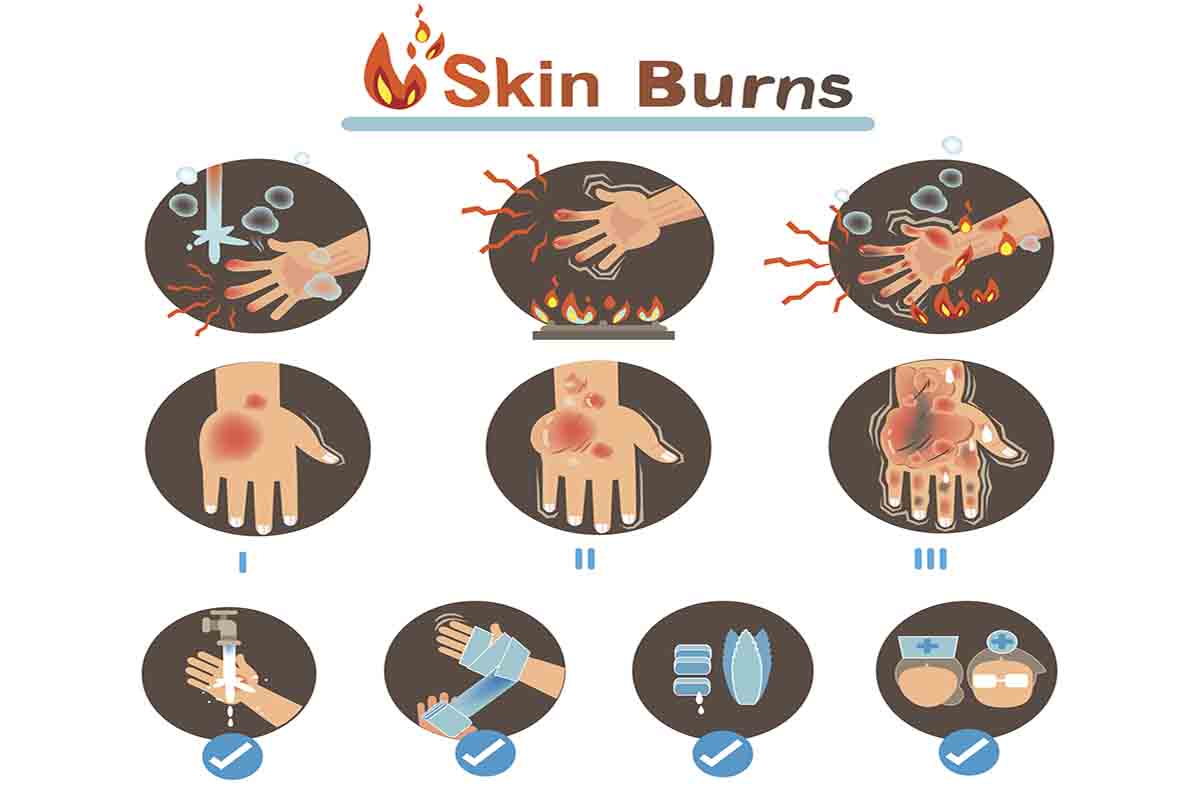Burns are ugly, they hurt and they're scary. But they can be treated with simple first aid steps. In fact, they're the one injury that must be treated before medical help arrives. The fact is that burned skin, unless treated right away, will get worse. Burns will get deeper below the surface of the skin because the heat continues to do damage.
When it comes to burns, degree has nothing to do with temperature. The terms first-, second-, and third-degree identify the severity of a burn. Of those, first-degree is the least harmful, and third-degree is the worst.
You might not think of your skin as an organ; after all, it hardly looks like a kidney or a heart. But the skin is a system of the body, and it's the largest organ of the body, too. It's the first shield against aliens, a natural-growing, one-person army of protection, germ warfare, and elimination. If something happens to the skin, the rest of your body is much more vulnerable to infection, shock, and disease.
Because first aid treatment depends on a burn's severity, it's important to correctly identify the severity of the burn injury. Check the appearance at the center of the wound. That's usually where the burn is deepest, which is your indicator of what degree of treatment is required.
When it comes to burns, the degree category of the burn has nothing to do with temperature. The terms first-, second-, and third-degree identify the severity of a burn. Of those, first-degree is the least harmful, and third-degree burns are the worst.
A burn, which affects that skin, is its worst nightmare come true. Unless you act fast, a burn can seep into the skin and invade your entire body.
The Top 10 Rules of First Aid
The Top 10 Rules of First Aid Read More
When you feel pain when you're burned it's because heat has destroyed skin cells. Burns can heal like cuts. A blister often forms first, covering the injured area. White blood cells attack bacteria underneath and a new layer of skin grows in from the burn's edges. When the burn is very deep or large, it can be difficult for new skin to grow fast enough to keep the bacteria out. This is how infected burns can happen.
The next few sections cover each degree and type of burn and specific first aid treatment for it.
The Right Way to Treat Burns — No Matter the Degree

There is a light (excuse the pun) at the end of the tunnel when it comes to burns. The fact is that burns can be treated successfully if first aid is administered quickly. By reading this, you're already ahead of the first aid burn game. You'll know how to act fast in case of an emergency. You'll know how to treat a burn, regardless of the degree or cause, while you wait for help to arrive.
- Prevent shock.
- Ease pain.
- Reduce the risk of infection.
What Not To Do When Treating Burns
The first aid measures you don't take can be as important as those you do take, especially when it comes to burnt skin. Here's the “short list” on what not to do:
- Do not pierce or open blisters. It leaves the burned person “wide open” for infection.
- Do not peel off burned dead skin. It not only leaves the new skin underneath too vulnerable to infection, but it can cause scarring.
- Do not attempt to peel away any clothing stuck to the burn. Pulling away the cloth can also peel away any healing skin. And, as anyone who's ever had a bandage pulled off knows, it can hurt too!
- Do not use butter, antiseptic creams, or any other “folk remedies” on burns. They can actually cause the infection you're trying to avoid! None of these remedies, especially butter, will do anything beneficial for major burns.
What Are First-Degree Burns? (And How to Treat Them)
Accidentally touching a hot burner, getting too much tropical sun, and holding a scalding hot pot are all ways you can get first-degree burns. First-degree burns are the most benign and most common burns of all. However, because first-degree burns irritate nerve endings (especially in fingertips), they can hurt a great deal.

First-degree burns have
slight redness or discoloration,
along with a bit of swelling and pain.
First-degree burns have slight redness or discoloration, along with a bit of swelling and pain. First-degree burns don't usually need professional medical attention. Simply cool the burn under cool, running water for several minutes to stop the burn from getting worse. You can give the injured person an aspirin (if he or she has no medical complications and never give children aspirin) and soothe the area with some aloe vera ointment or burn cream.
Luckily, healing is very quick because only the outermost layer of skin is affected.
You can tell these burns not only by the amount of howling the sufferer does when the accident occurs, but also by the resulting red skin. There will be no blisters on a first-degree burn, nor will the skin be broken. There may be some swelling on and around the burned area. This kind of burn affects only the outermost layers of the skin.
What Are Second-Degree Burns? (And How to Treat Them)
By the very nature of their place on the “burn hierarchy,” these burns require some medical treatment. You can get a second-degree burn from too much sun, scalding hot soup, coffee, tea or quick flash burns from gasoline or kerosene lamps.
Second-degree burns look red or mottled, and generally have blisters. These burns may ooze or swell. Second-degree burns are distinguished by the blistery, red blotchy marks they leave on skin. Blisters form in these burns because the burn penetrates deeper into the layers of skin, releasing body fluids that erupt and cause blisters on the surface. Sometimes the burned area will swell or ooze, and it is painful.

Second-degree burns look red
or mottled, and generally have
blisters. These burns may ooze
or swell.
Pain from second-degree burns can be vastly reduced by preventing air from getting at those tender, exposed nerve endings and tissues. Here's the best emergency first aid, step-by-step:
- Submerge the burned area in cool water. If the burn occurred on the chest or back, pour cool water from a bucket directly onto the burn.
- Keep the cool water on the burn until medical help arrives. If the burns are minor, keep them in cool water for at least five minutes.
- If the burns are extensive, you can apply a cool, wet cloth to the affected area—but only if the dressing is wrapped in plastic. Cloth tends to adhere to burns, and it can worsen the pain if a physician has to pull it off to treat the burn.
- If the burns are minor, you can treat them in the same way you'd treat first-degree ones. You won't need medical help. Simply pat the area dry and place a loose sterile cloth over it.
What Are Third-Degree Burns? (And How to Treat Them)
Third-degree burns are serious — deadly serious. If you encounter someone who has a third-degree burn, get medical attention fast! How do you know a third-degree burn from a first- or second-degree one? The injured person is literally burned, the skin is charred and white. All of the layers of skin are destroyed (sometimes quite obviously) with this kind of burn.
Do You Need to Go to The Hospital With a Third-Degree Burn?
Did you know that third-degree burns hardly ever hurt at all, at least not initially? That's because nerve endings have been completely burned, and the brain hasn't yet received the painful message.
Third-degree burns come from situations like the ones you read about in the paper. Firemen rushing from burning buildings. People rolling on the ground with their clothes on fire. Pots of boiling water spilling on vulnerable skin. Accidents involving electrical outlets. Any of these can cause serious burns and shock.
If the burned person shows any of the signs of shock, immediately treat that before taking care of the burn. See Performing Mouth-to-Mouth Resuscitation for step-by-step instructions on treating shock.
As we've already mentioned, third-degree burns are the most severe of all burns. They require medical treatment and precise first aid care. If you know what you are doing, you can help prevent infection from spreading.

Third-degree burns look like deep
wounds and often appear to be white
and charred.
Third-degree burns look like deep wounds and often appear to be white and charred.
- Call for medical attention if access is immediately available.
- Treat for shock, if necessary. This is especially true if the burn is caused by electric shock.
- If you suspect chemical burning, especially from dangerous acids, you need to take first aid care one step further in order to stop the burn from spreading. As soon as you've called for medical help, pick up the phone and call the local poison control center. As with any type of poison ingestion or inhalation or burn, these specialists can tell you exactly what you need to do.
- Remove any tight clothing or jewelry that's not on the actual burned area. With third-degree burns, there's always the danger of swelling which can cause blood vessels to constrict and create other complications.
- You can submerge the burned area under cool running water, but avoid ice. Too much cold can exacerbate shock.
- Pat the area dry and place a loose, sterile cloth over the area.
- If hands are burned, elevate them, keeping them higher than the heart. This can be done by gently placing pillows under the injured person's arms.
- Burned legs and feet should also be elevated to keep blood flowing smoothly.
- Keep the injured person still. Do not let him or her walk around.
- If the face is burned, keep checking for breathing complications. If airways seem to be blocked, follow the instructions for performing mouth-to-mouth resuscitation.
- Above all, get the burned victim to a hospital. Third-degree burn victims are prime candidates for infection, pneumonia, and other complications, and they need medical attention fast.


